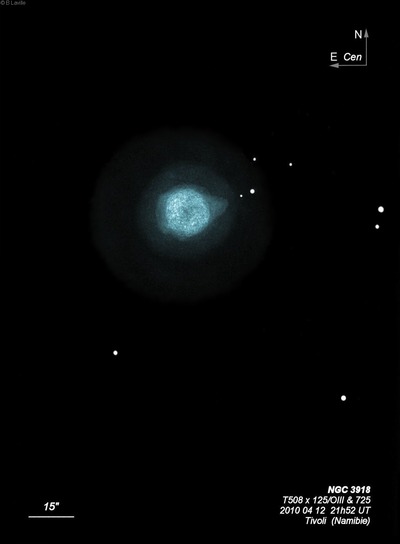
John Herschel discovered NGC 3918 = h3365 on 3 Apr 1834 and described this planetary as "perfectly round; very planetary; color fine blue;...very like Uranus, only about half as large again and blue." In a letter to Francis Baily from the Cape of Good Hope dated 22 Oct 1834, he added "On the 3d of April I discovered another fine planetary nebula, having a perfectly sharp disc, without the least haziness, of about 6" diameter. The most remarkable feature about this is its evident blue colour, which needs not the presence of lamp light, or that of any red star, to be very conspicuous, as it appears when the nebula stands alone in a dark field." On 5 Feb 1835 (sweep 543, the night described in his diary as "most superb" and "having attained the sublime of Astronomy - a sort of ne plus ultra") he wrote, he noted the color as "a beautiful rich blue, between prussian blue and verditter green...its outline is sharp and clean, and perhaps a very little elliptic. A feeble lamp light gives a deep indigo contrasted color."
James Dunlop first recorded this planetary in the Brisbane Star Catalogue of 1826 as a "fine blue star” (#3807) but did not note its non-stellar appearance.
Joseph Turner and Pietro Baracchi (1885) sketched the planetary with the Great Melbourne Telescope (unpublished plate V, figure 57).
The term "planetary", of course, had been used by William Herschel but he never made an analogy to Uranus. John Herschel wrote in his "A Treatise on Astronomy”, "They [planetary nebulae] have, as their name, exactly the appearance of planets." He also reported the colors of several as shades of blue (NGC 7009, 7662, 3242, 3918). See additional comments on M57.
300/350mm - 13.1" (2/20/04 - Costa Rica): at 195x, this 8th magnitude planetary appears as a beautiful 10"-12" blue disc with a very crisp edge. No central star was glimpsed or other structural details at this magnification though the surface brightness is unusually high. Situated in a rich star field but set near the middle of a oval 12'-13' ring of mag 11 and 12 stars which are near the periphery of the 17' field at 195x! Located 8.4' SSW of mag 8.1 HD 102817 and 19' SW of mag 5.6 HD 103101. The open cluster NGC 3960 lies 90' N.
400/500mm - 18" (7/10/05 - Magellan Observatory, Australia): at 76x appears as a bright, beautiful blue cosmic egg floating in a rich star field, ~15" diameter. The surface brightness is extremely high and uniformly lit, with a sharply defined edge to the disc. At 228x, the planetary appears to be set in the middle of an absorption hole in the Milky Way as there are very few faint stars in a 4' to 5' circular region surrounding the planetary. Outside this hole, the Milky Way background is very evident and fairly bright.
18" (7/8/02 - Magellan Observatory, Australia): at 171x, the "Blue Planetary" appears as a bright, round disc, ~15" diameter with a vivid blue color (V = 8.2). The surface brightness is very high and the edge of the halo is crisply defined, but no structural details or central star were noted. Good response to UHC filter, although it was unnecessary for a good view. The Milky Way is quite rich here in faint stars but the planetary seems to be set a darker, circular hole without the faint background glow - a contrast affect with the PN?
600/800mm - 24" (4/11/08 - Magellan Observatory, Australia): at 200x the "Blue Planetary" has an even, extremely high surface brightness disc of 15" and a saturated, vivid blue color. The edge is crisply defined and the disc has a uniform surface brightness. At 350x, the planetary is oval or irregular, perhaps 18"x15". There was no sign of the central star, though I didn't try high powers.
Notes by Steve Gottlieb